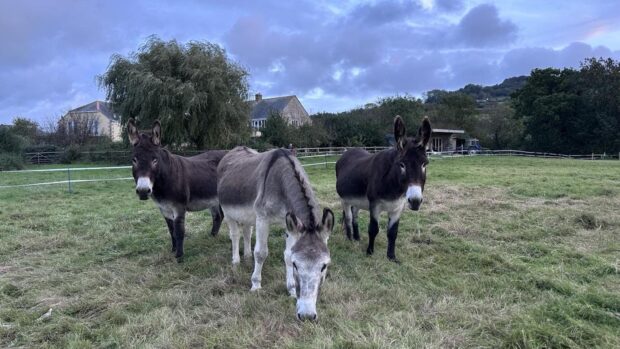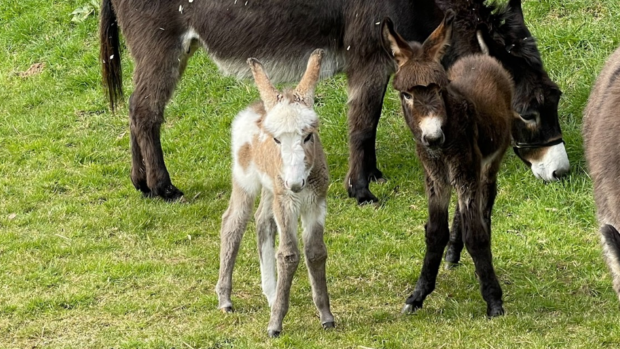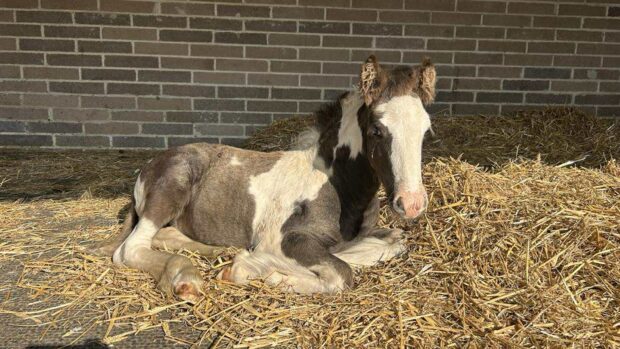The Donkey Sanctuary has created a “pioneering” adoption of a suckling system to help the natural development of orphan foals.
A groom at the charity came up with the idea when week-old orphan foal Sam was relinquished to the charity and needed to be bottle-fed every three to four hours. The groom had previously seen artificial suckling systems used for lambs.
“The team caring for Sam noticed potentially concerning behaviours developing, such as rearing up and biting in a playful manner, and the decision was taken to adapt an artificial suckling system to replace hand-rearing,” said a Donkey Sanctuary spokesman, adding that the groom had previously seen such systems used for newborn lambs.
With the charity’s new feeding system Sam’s milk formula is accessible 24 hours a day, and through monitoring it was observed he suckled at a variable rate throughout the 24-hour period, replicating natural rearing behaviour.
“Sam also suckled at times without taking in milk, demonstrating that suckling behaviour is a key part of maternal nurturing,” said the spokesman.

The Donkey Sanctuary’s adapted artificial feeding system
Ben Hart, Donkey Sanctuary senior lead in behaviour and human behaviour change, said orphan foals are one of the “greatest challenges” to equid care and welfare.
“Hand-rearing is often the only option for equine sanctuaries when an orphan arrives. However, too much inappropriate handling from humans can result in behavioural issues as the foal grows,” he said.
“Male donkeys can be extremely playful, often engaging in aggressive play well into adulthood. Foals learn a great deal about the world by biting things and interacting with them in this way. Bottle-reared foals may exhibit more of this behaviour because of incorrect handling, such as being pushed away, which the foal interprets as positive, playful attention.”
The artificial system consists of a plastic tube leading from an enclosed milk bucket to a bottle teat, which is attached to a stable door at an appropriate height. The formula is heated by a machine as it passes through the tube, on its way to the foal.
“The automatic system not only allows the foal to self-administer and potentially feed more naturally, but research also shows ad-lib feeding may also promote healthier growth and development,” said the spokesman.
“The system also allowed for 24-hour camera monitoring and the team caring for Sam observed other activities replicating the natural behaviour of foals. These included head-butting the teat, chewing or rubbing the teat and staying close by even when not feeding – all behaviours considered to be non-nutritive suckling and similar to when foals stay close to their mothers in the first five months of life.”
The spokesman said Sam has “flourished” in the charity’s care and when he was old enough to be rehomed, he was matched to one of the charity’s volunteers who helped look after him at the Donkey Sanctuary’s Paccombe Farm.
“The feeding system was adapted so successfully for Sam that the Donkey Sanctuary Ireland used it to help rear a rejected foal called Bugsy, when he came into their care. The team further adapted the system, building a structure to house the suckling equipment with space for the foal to enter and reach the teat,” said the spokesman.
“This was an improvement on the original system, as it allowed Bugsy to live with similarly aged companions without disrupting the feeding system. This in turn minimised social isolation, which can compound the development of behavioural problems.”
Ben added that developing the system is a “great” example of how collaboration and lateral thinking can significantly improve not only the health, welfare and behavioural development of donkeys in the charity’s care, but also equines around the world who can learn from the “pioneering” work.
He said: “Developing this artificial feeding system, which mimics the natural environment, is a great example of how team collaboration, academic excellence and lateral thinking can significantly improve not only the health, welfare and behavioural development of donkeys in our care but also equines around the world who can learn from our pioneering work.”
You might also be interested in:

‘She’s lovely with him’: Shire mare takes on orphaned colt alongside her own foal

The Orphan Foal: A Practical Guide — a must-read for anyone breeding horses professionally or for pleasure
Time is of the essence when things go wrong and this book will be a valuable guide to anyone involved

Subscribe to Horse & Hound magazine today – and enjoy unlimited website access all year round
Horse & Hound magazine, out every Thursday, is packed with all the latest news and reports, as well as interviews, specials, nostalgia, vet and training advice. Find how you can enjoy the magazine delivered to your door every week, plus options to upgrade your subscription to access our online service that brings you breaking news and reports as well as other benefits.




